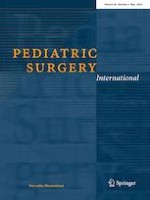Erschienen in:

26.03.2020 | Original Article
Determining acute complicated and uncomplicated appendicitis using serum and urine biomarkers: interleukin-6 and neutrophil gelatinase-associated lipocalin
verfasst von:
Mohit Kakar, Mathilde Delorme, Renars Broks, Lasma Asare, Marisa Butnere, Aigars Reinis, Arnis Engelis, Juta Kroica, Amulya Saxena, Aigars Petersons
Erschienen in:
Pediatric Surgery International
|
Ausgabe 5/2020
Einloggen, um Zugang zu erhalten
Abstract
Purpose
The study aim is to determine whether serum and urine interleukin-6 (IL-6) and neutrophil gelatinase-associated lipocalin (NGAL) can be included in the early diagnostic algorithm for pediatric appendicitis.
Methods
Prospective single-center cohort study included 92 children divided into control, acute complicated appendicitis (AcA) and acute uncomplicated appendicitis (AnA) groups. Serum and urine samples were assayed for IL-6 and NGAL preoperatively, and on the second and fifth postoperative days. Intraoperative and bacteriological findings divided the appendicitis patients.
Results
Average serum biomarker levels were higher in appendicitis patients versus the control, and the following values were produced via receiver operating characteristic (ROC) analysis. NGAL and IL-6 cutoff values were 113.95 ng/ml and 24.64 pg/ml, respectively, NGAL had 68.3% sensitivity and 65.5% specificity, while IL-6 had 72.6% and 86.2%. Comparing AcA and AnA, IL-6 was the only biomarker of significance yielding 77.4% sensitivity and 58.1% specificity with a 26.43 pg/ml cutoff value. Urine biomarkers were non-specific in differentiation appendicitis severity and ultimately, between infectious and non-infectious disease.
Conclusion
Although NGAL provided measurable useful diagnostic information in evaluating children for appendicitis, its values were not sufficient for appendicitis severity. Serum IL-6 remains a strong biomarker for suspected acute appendicitis and has promising results predicting its severity.











